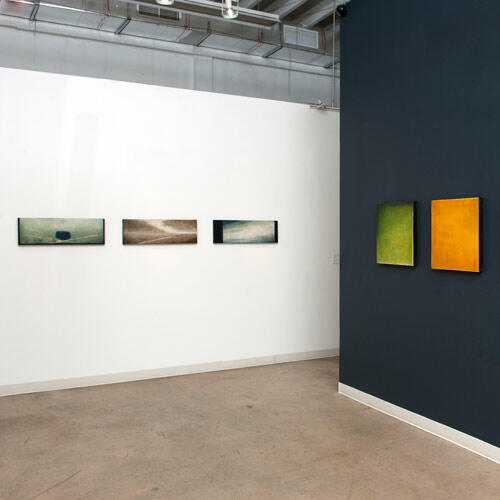Sebastian Spreng
Kelley Roy, Miami
Borges, an inhabitant of libraries that broadened his imagination to the point of showing him the possibility of the Aleph, which concentrates in a minimum diameter all that has been, is, and will be, did not allow novelty to impress him. Besides, he understood that every creator produces a single work over the course of his/her life, and that variations do not annihilate its essential oneness.

In the case of Sebastian Spreng, a single landscape is rendered ad infinitum: the interior of a poetic imagination that gives rise to rivers, seas, ships enveloped in mist, hazy mountains and woods, moons and thresholds of architectures that are spatial-temporal vortices where the modes of creation converge.
Increasingly focused on a small dimension, those paintings of his, which are not informed by an external territory but by the reveries of “a painter who knows (a lot) about music,” give us access to more recondite passageways leading to a poetic iconography modeled by his relationship with this orphic art. Play and mystery or lightness and transcendence might be the signs characterizing his exhibition “Salad Bar” at Kelley Roy Gallery, featuring an installation composed of 240 small-format paintings that may be reorganized into different combinations.
In fact, the installation incites classification. The viewer may notice leitmotifs, such as the recurring figure of a solitary tree on the horizon appearing once and again in a manner of reiteration that evokes that of the melodic phrases that accompany the reappearance of a person or situation, as in Wagner’s operas. And this reading − linked to the possible reorganization of the installation − might allow the creation of successive paintings of trees charged with an archetypal meaning associated to the myths of all times − the figure that connects the subterranean and the celestial − but that are also a type of self-portrait. Spreng admits that the tree he carves with slow movements burying a burin in the fresh paint is “a hymn to the survival of man and to my own survival.”
The last tree he painted in this open series into which he incorporated suggested birds or flowers to the light of his rivers and seas or of solitary fortresses in the open country, was entitled − like Mahler’s composition − The Song of the Earth. But this “earth” is much more than nature; it is a land mediated by the universe of symbols of different cultures, by the history of art itself, and by Spreng’s cognitive relationship with the aforementioned.
In terms of the contemplation of the landscape, we would have to go back to his admiration for the romantic Gaspar David Friedrich and follow along those lines to reach the moon Gerhard Ritcher represented in his monotypes of the Elbe series, or the way in which the latter utilizes his characteristic ‘blur’ to fuse artistic mediums and genres. What is blurred in Spreng’s work is the distinction between reality and reverie, and beyond forms, what he intends to bring up − like music itself − is a time drive. He can contain it in a polyptych featuring the four phases of the moon in colors that refer the viewer to different cultural universes. There is also a temporality − in a way that fuses with his formal explorations − in the gradual blackening of figurative horizons that end up in absolute black or white, those paths towards worldly silence and pictorial construction. In both cases the process is achieved, as in Reinhardt, through the juxtaposition of layers containing a buried memory of color.
A triptych inspired by water contained in rectangles − the swimming pool − is now a grid multiplying light. “There are no swimmers any more, no more water, just the web that light forms at the bottom,” Spreng says. Perhaps what he seeks to attain in his paintings is the drive of the time of myth, in which initiation and the symbolic mediation with life is represented time and again.




